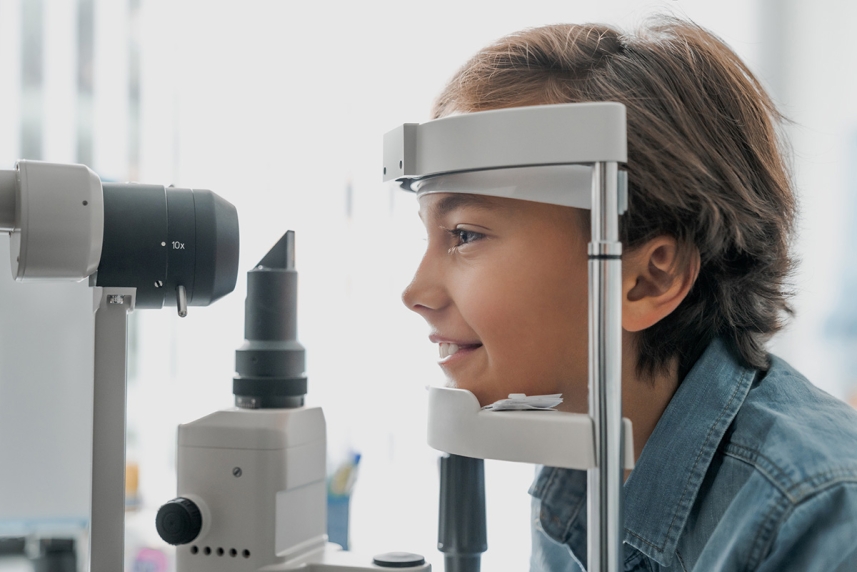Why kids with diabetes may need regular eye exams
High blood sugar may damage the eyes over time. Here’s how to keep a child’s sight sharp.

It’s important to keep a kid’s vision healthy, as they’re learning, reading books, seeing the smiling faces of their friends and watching the screens on their digital devices.
That may be even more important for the more than 350,000 children and adolescents who have diabetes in the United States.1 That’s because diabetes may affect a child’s vision or eye health.
Parents of children with diabetes may already be talking with their pediatrician about managing their blood sugar, physical activity and even medication. But another health care professional parents may want to be in touch with is an eye care provider. Here’s why.
Stay on top of your eye health with an in-network provider. Search for an eye care provider now.
What vision issues may kids with diabetes have?
One vision-related condition that may develop in kids with both type 1 and type 2 diabetes is diabetic retinopathy. It can be caused when a child’s blood sugar levels are too high. This may damage the blood vessels in the retina over time.2 (The retina is the light-sensitive layer of tissue at the back of the eye.3)
Changes in the retina may not happen overnight. Research involving children with type 2 diabetes shows that pediatric patients may have a higher risk of developing diabetic retinopathy the longer they have diabetes.4 Five years after the diagnosis, 1 in 4 pediatric patients had diabetic retinopathy.4
How to ensure that the eyes of kids with diabetes stay healthy
It’s a good idea for parents of kids with diabetes to know the importance of getting them screened for eye-related issues. They may want to make an appointment to screen them for diabetic retinopathy within a year of their diabetes diagnosis.5
Parents may want to do this whether their child is experiencing symptoms or not.5 (Keep in mind that, sometimes, kids may not be aware that something is off with their vision.)
The screening could involve seeing an eye care provider who will dilate their kid’s pupils. This allows the eye care provider to look at the retina and monitor the health of the blood vessels in their eyes.
Sometimes, kids with diabetes may experience other eye symptoms if they’re having issues with managing their blood sugar. “When blood sugar gets too high or low, a child can experience a lot of blurry vision,” says Karin Underkoffler, O.D., an optometrist with Reliant Medical Group in Westborough, Massachusetts.
That blurry vision may happen because the lens of the eye may swell.6 (The lens is the clear disk in the front of the eye behind the pupil; its job it is to focus light on the retina.7) “Sometimes with kids, we see that blurriness is the first sign that something is off,” says Dr. Underkoffler.
Luckily, blurry vision doesn’t always mean there may be permanent damage to their vision, she adds. But it may be a sign that their blood sugar levels may be impacting their vision, and it could be worth getting it checked out.
If a kid with diabetes notices symptoms like blurriness, their parents will want to make a follow-up appointment with their eye care provider. That’s important even if they may not be due for another eye appointment anytime soon. When left untreated, diabetic retinopathy may cause vision damage.6
So, what does it mean if an eye care provider thinks they may see signs of damage in the back of a child’s eye? It may suggest that their blood sugar is not as well-controlled as it could be, says Dr. Underkoffler. “We recommend that parents make an appointment with their child’s pediatrician or endocrinologist to let them know that they have this damage. It can’t go on, and it needs to be treated,” she says. (An endocrinologist is a type of doctor that specializes in hormone-related diseases such as diabetes.)
At that point, the child may be referred to a retinal specialist for further testing and treatment.
How a parent may help their child lead a healthy lifestyle
Kids who have elevated A1C and blood pressure may be at higher risk of developing diabetic retinopathy, research suggests.8 (A1C is a type of measure of blood sugar levels in the body.)
That’s why another important thing parents may do is encourage their children to practice healthy lifestyle habits, says Dr. Underkoffler. What’s good for their body and blood sugar control is also good for their eyes. A doctor caring for a child with diabetes may recommend that they:9
- Get physical activity for at least an hour every day
- Limit screen time to 2 hours a day
- Make nutritious food choices
- Monitor their blood sugar
Although there may be other challenges for parents when their child has diabetes, having a team of health care providers on their side may make treatment more manageable. This could help them decrease the risk of their child developing vision-related issues.
It’s a good idea for parents to be in regular contact with their child’s eye care provider. Every child is different, so it’s important for parents to be on top of potential follow-up visits. “I talk to parents about seeing a child with diabetes every year,” says Dr. Underkoffler. “I don’t want to take risks with their vision, so I’d rather see them regularly.”
Providers in the UnitedHealthcare Vision Network are here to help keep your vision healthy. Search for an in-network provider now.
Sources:
- National Diabetes Statistics Report Centers for Disease Control and Prevention, May 2024.
- Diabetic retinopathy National Eye Institute, last updated August 2024.
- Retina National Library of Medicine: MedlinePlus, last reviewed April 2023.
- Global prevalence of diabetic retinopathy in pediatric type 2 diabetes JAMA Network Open, March 2023.
- Diabetic retinopathy screening Children’s Hospital of Philadelphia.
- Diabetes and eye disease National Library of Medicine: MedlinePlus, last reviewed February 2023.
- Lens National Cancer Institute.
- Prevalence, progression, and modifiable risk factors for diabetic retinopathy in youth and young adults with youth-onset type 1 and type 2 diabetes: The SEARCH for Diabetes in Youth study Diabetes Care, April 2023.
- Pediatric type 2 diabetes StatPearls, last updated November 2023.


